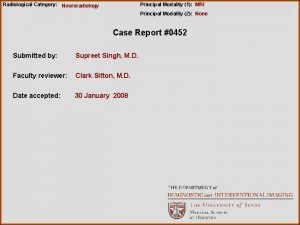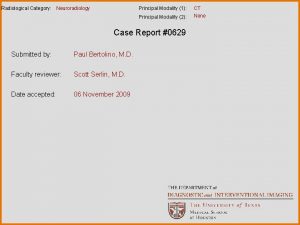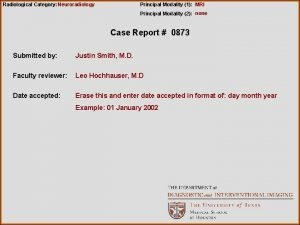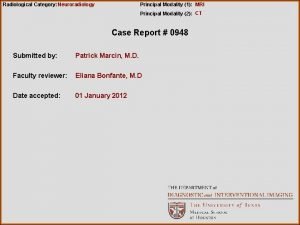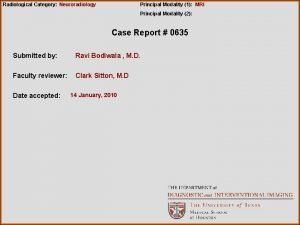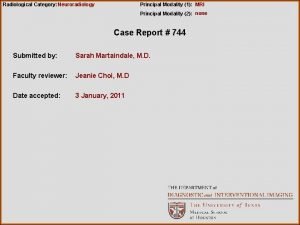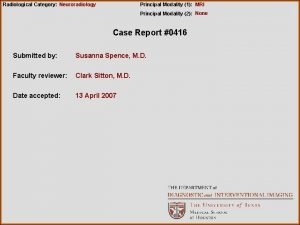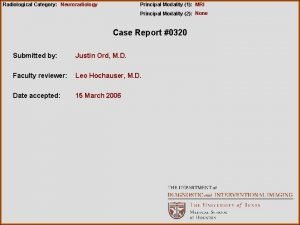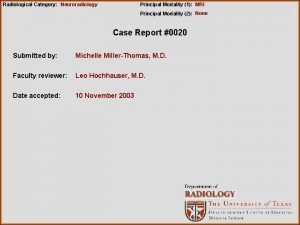Radiological Category Neuroradiology Principal Modality MRI Case Report











- Slides: 11

Radiological Category: Neuroradiology Principal Modality: MRI Case Report # 0003 Submitted by: Majdi Radaideh , M. D. Faculty reviewer: Clark Sitton, MD Date accepted: 29 January 2003

Case History 35 -year-old female with severe headaches and visual field symptoms. The patient also complained of left sided weakness.

Radiological Presentations T 1 w/o gadolinium

Radiological Presentations T 1 w/o gadolinium

Radiological Presentations T 2 and PD

Radiological Presentations T 1 post Gad

Radiological Presentations T 1 post gadolinium

Test Your Diagnosis Which one of the following is your choice for the appropriate diagnosis? After your selection, go to next page. • • • Craniopharyngioma Pituitary adenoma with suprasellar extension Metastasis Hypothalamic, chiasmatic glioma Dermoid, teratoma Cavernous sinus meningioma

Findings and Differentials 1 - T 1 homogenous hypointense right parasellar / suprasellar mass. 2 - Intense contrast enhancement with dural extension having the appearance of dural tail that extends to the dura of the right cranial fossa and right tentorium. 3 - The mass is encasing the right supraclinoid ICA, causing severe narrowing and leads to slow flow and enhancement in the petrous and cavernous portion of the right ICA. 4 - Heterogeneous T 2 signal with dark areas related to hemorrhagic changes or calcification in the mass. 5 - Enhancement of the dura of the right optic nerve. 6 - Right anterior middle cranial fossa arachnoid cyst. DDx • • • Cavernous sinus meningioma Craniopharyngioma Pituitary adenoma with suprasellar extension Metastasis Hypothalamic, chiasmatic glioma Dermoid, teratoma

Discussion: Cavernous meningioma Suprasellar Meningioma (Cavernous meningioma) Incidence: 10% of all intracranial meningiomas Origin: from arachnoid + dura along tuberculum sellae / clinoids / diaphragma sellae / cavernous sinus with secondary extension into sella; NOT from within pituitary fossa Imaging features üHypothalamic / pituitary dysfunction (rare); üIrregular hyperostosis = blistering adjacent to sinus (HALLMARK of meningiomas at planum sphenoidale / tuberculum sellae); üPneumatosis sphenoidale = increased pneumatization of sphenoid in area of anterior clinoids + dorsum sellae (DDx: normal variant); üBroad base of attachment; üIntense homogeneous enhancement (may be impossible to differentiate from supraclinoid carotid aneurysm on CT) Blood supply: posterior ethmoidal branches of ophthalmic artery, branches of meningohypophyseal trunk MR: Large mass, isointense to gray matter on T 1 WI + T 2 WI Hyperintense flattened pituitary gland within floor of sella Marked homogeneous enhancement on T 1 WI DDx: metastasis, glioma, lymphoma References: 1. Dahnert's Radiology Review Manual, Fourth Edition.

Diagnosis Cavernous meningioma
 Ohsu neuroradiology
Ohsu neuroradiology Erate category 2 eligible equipment
Erate category 2 eligible equipment Center for devices and radiological health
Center for devices and radiological health National radiological emergency preparedness conference
National radiological emergency preparedness conference Radiological dispersal device
Radiological dispersal device Tennessee division of radiological health
Tennessee division of radiological health Mri principal
Mri principal Best worst and average case
Best worst and average case Apollo planogram
Apollo planogram Deontic modality
Deontic modality Epistemic modality
Epistemic modality Deontic and epistemic modality exercises
Deontic and epistemic modality exercises






